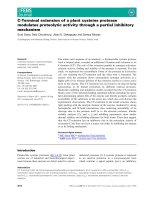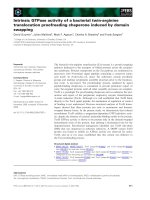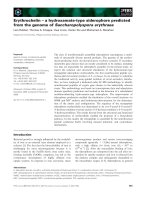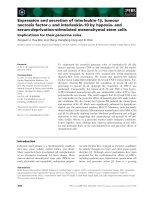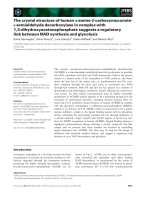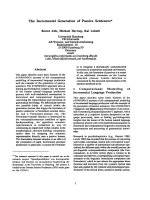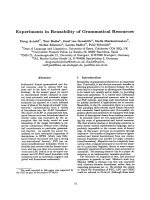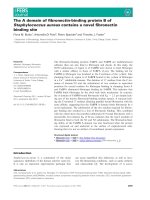Báo cáo khoa học: "Toward a Redefinition of Yea/No Questions" pot
Bạn đang xem bản rút gọn của tài liệu. Xem và tải ngay bản đầy đủ của tài liệu tại đây (387.28 KB, 4 trang )
Toward a Redefinition of Yea/No Questions
Julia Hirschberg
Department of Computer and Information Science
Moore School/D0
University of Pennsylvania
Philadelphia, PA 19104
ABSTRACT
While both theoretical and empirical studies of question-
answering have revealed the inadequacy of traditional definitions
of Ve*-no questions (YNQs), little progress has been made
toward a more satisfactory redefinition. This paper reviews the
limitations of several proposed revisions. It proposes a new
definition of YNQs baaed upon research on a type of
conversational irnpIieature, termed here setdar
imp/ie,,ture, that helps define appropriate responses to YNQs.
By representing YNQs as sealer qtteriee it is possible to support
a wider variety of system anti user responses in a principled way.
I INTRODUCTION
If natural language interfaces to question-answering systems are
to support a broad range of responses to user queries, the way
these systems represent queries for response retrieval should be
reexamined. Theorists of question-answering commonly define
questions in terms of the set of all their possible [true) answers.
Traditionally, they have defined t/us-no quesgiofts (YNQs) as
propositional questions (?P) or as a special type of
alternative question (?P V ?Q), in which the second alternative
is simply the negation of the fir.~t (?P V ?"P). So 'Does Mary like
skiing?' would be represented as flikr(lffary,skling) or
?like(Alary.okiing) V "~-Iikt(Mary, skiing) and the range of
appropriate responses wouhl be gee, no and, possibly, unknown.
• " ilowever, both theoretleal wnrk and empirical studies of naturally
occurring question-answer exchanges have shown this approach to
be inadequate: ?~s, .o. and unknown form only a small portion of
the set ¢,f all appropriate responses to a YNQ. Furthermore, for
some YNQ's. none of these simple direct responses alone i~
appropri:,te.
While it is widely recognized (llobbs, 1979, Pollack, 1982} that
indirect resp.nses I to YNQs represent an important option for
respondents in natural discourse, standard theories of question-
answering have n,~t been revised accordiugly. A practical
COllsPquence surface~ when
attempts are made t.o support indirect
responses to YNQs computationally. For lack of alternative
representations, question-answering systems which would permit
indirect responses must still represent YNQs as if the direct
respons-s were the 'norm', and then resort to ad hoe manipulations
to generate second-class 'indirect' responses, thus perpetuating an
asymmetric distinction between 'direct' and 'indirect' responses.
However. resea.'h under way on how a type of generalized
conversational implieatttre, termed here scalar
irrtplieature, can be used to guide the generation and
iaterpretion of indirect respt,nses to YNQs
sugges/,s a
revi~ed
representation fi)r YNQs which scrotums)dates a wide variety of
responses in a uniform way.
II CURRENT REPRESENTATIONS OF YNQ, S
Among st:~ad:,rd accounts of ¥NQs, I-lintikka's (l.lh:tik.~a, 197~)
is one of the shnl)lest and mo~t widely accepted, c~.,mbinh~g the
llndirect r~sponses to YNQs tr~ defined h~:re as responses other than
lltR,
n0, or some expression of ignorance.
concepts of YNQ" as pn,positional question " and as alternative
question; as such, it will be used below to represent traditional
approaches in general. To define attswerhood, the conditions
under which a response eonnts as an answer to a natural-language
query, Hintikka divides qneriq~s into two parts: an imperative or
optaGve operator {[). roughly expressing 'bri,g it about that', and
a daesideratu~,n, a specification of the epistemie state a questhmer
desires. For Hintikka, a YNQ is a ~peciai case of alterna(Jve
question in which the negative alternative 'or not P' has been
suppressed. So the desideratum of a YNQ is of the f¢~rm
([
know
thai P) V {I kin, u, that #t~3+P}. where net-l- indicates the
negation-fi)rming process. 'Does Mary like skiing?' thus has a.s its
desideratum I know that ,~htrg li];e.* skiing or I kno~ ihat Aiary
does not like skiing, or, more concisely, fK~Jike{Marg, skling) V
Ks~likc{'Marll, ekiing), where K S is the epistemic representatitm of
'S knows that'. The full sense of the query is then 'Bring it aboot
that 1 know that Mary likes skiing or that I know that Mary does
not like skiing', which can be represented by ! [KsP V K.~',P).
Possible resp.nses are simply {P,-,P}, or {yes,no).
A. tI_~othesls Confirmation
Bolingcr (Boliuger, 1978) has called such interpretations into
question by showing that YNQs may have very different meanings
from their alternatlve-questioa counterparts; they also have more
restricted paraphrase and intonation patterns. In 13oliuger's view
the term I/US-no qtterl/ has hypnolized scholars into a.ssurrling
that, simply because a class of question can be answered by a 2us
or no, the~ altern:ttives are critcrial, and every YNQ is intended
to elicit, one or the other. He proposes instead that YNQs be
viewed as hypotheses put forward for confirmation, arncadmenL or
diseonfirnladon - in any degree. Thus, in Bolinger's exampie (l),
the
(1) Q: Do you like llonolnlu?
R: Just a little.
questioner (Q)'s hypothesis 'you like tloaoh, iu' is amended by ~he
respondent (R) in a re ponse v, hich is neither .t, es n,~r no bnt
somewhere in between. In his example (2), Q's hypothesis 'it is
(2) Q: Is it difficult?
R: It's imposeS'de.
difficult' is confirmed by R's as,ertion of a more positive resi~onse
than a simple go.;.
While Bolingcr makes a good ca'.:.e for the inadequacy of sttmdard
views of YNQs, the revisi,m hv I)mposes is itself :,~, ]i,tited. '~t',~
imp~,~ible', in (2). d.',e:; n:,.'e than simply pr~'-, t a strong
affirmation of the hypoth,'~is 'it is dilficult' - it Frovid~ new :'.rid
unrequested though perlit nt inr,,r.tati.n. In fact, 'str,mg
affirmation' might better t)e provided by a respon e uch as '1 am
absolutely sure it's difficult' than by "he response he suggests. And
ther,~ are equally appropriate responses to the queries in (l) and {2)
that are not easily explained in terms of degree of hypotl~esis
confirmatit,n, u.~ shown iu (3) and (4).
/48
(:~;)
Q: 1),, you like
! h,,a.hllu?
a.
R: I don't
like llawaii.
b. R: I lik~- Ililo.
(4} t~: Is it dif~'icult?
a. l,': It could be.
b. It: Mike says so.
Finally, l~.ii~ger does not propose a representatiozt to
accommodate hi~ hy~,~,the~is-confirmation model.
B. Fo~oesed YNf~.~
Similarly, Ki,'fer (Kid,for, 19~;0) points out evidence for the
inadt,quacy of the standard view of YNQs, but proposes no unified
sohrti.n. In a stt~dy of the indirect speech acts that may be
p~.rh~rm,'d I,? "(NQ~, h," nc~le~ that certain YNQs, which he terms
.focussed YTVQs, aetu:dly function as v,h-queslions. Focussed
YNQs I'¢,r Kit'f,'r are YNQs that are marked in some way
(:~l)parenlly by sire:.~ i to il~di,.ate a background aasuntption
which Q and l{ typic:ally share. For example, (Sa) is not a
focussed YNQ while {Y~bHY, d ) are. While any of the four may be
auswrted with 9~,~ or
a. 1.~ John h,aving for .~tockholm tomorrow?
b. Is .Mhn leaving for Stockholm TOMORROW?
c. Is John h.aviug for STOCKIR~I.M tomorr,~w?
d. [s JOIIN leaving fi~r St~wkh.~dm
tom~)rrow?
no, ii is also po~.ii,le that, if Q a~ks (,Sb). she want~ R to answer
the question 'When is Johi! leaving for Stockholm?'; if she a.,;ks (Se)
she may want to know 'Where is John going tomorrow?'; and if
she asks (Sd) she may want to know 'Who is leaving for Stockhohn
tomorrow?" Titus a f,~cussed YNQ resemhles the wh-question that
might be formed by replacing the focussed element in the
desideratum with a corresponding Pro-element. In Kiefer's
analysis, only one eh't~ent
can
he focussed, so resl~mses such as
'lie's leaving for Paris Thursday' will not be accommodated.
Although Kiefer does not propose a representation for focugsed
YNQs, a di :j,nc! resembling the desideratum of a wh-question
might I,e added to the traditional representation to areommodate
his third :tlterna|ive: for (5d} this might take the form 'Is John
leaving for Stoekhohn tomorrow, or, if not, who is?' or, in
Hintikka's notation,
! KQleaving(.Iohn,Stockholm,tomorrow) V
Kq-leav ing{.Ioh n,Stoek h-Ira,tomorrow) V
3x Kqleav ing(x,Stoek holm,tomorrow).
This represenl.atiou reflects another problem posed by Kiefer's
analysis: the third disjunet is appropriate only when the second
also is and not when the direct response ~les is true. For example,
a response of 'Bill is' to (Sd) seems to convey that John h not
leaving for Stockhoha tomorrow. Thus viewing some YNQs as
wh*qm,,qions req.ires a rather more coml~lex representation than
simply adding a wh-question as a third disjunct. * In addition,
defining different representations for various YNQ subtypes seems
a le~s than satisfactory solution to tbe linfitations presented by
current representations of YNQs. A more unified solution to the
problems identified by Bolinger and Kiefer would clearly be
desirable. Such a solution is suggested by current research on the
role conversational implieature plays in accounting for indirect
re.~pons~s to YN~.~)s.
III CONVERSATIONAL I'MPLICATURE AND YNQS
In a large cl:~s of in,!irect respon:~e.~ to YNQs, query and
response each refi, r to an entity, attribute, state, activity, or event
that can bo viewed as appearing on sorae
eea~e;
such references
"In f~et, the third di~jon~t would have to be something like
~ KQ-~leaving(Jol, n,~3oekholm,to~,~,~rrou,} A tea~ingfz.Sterkl~olm,tomorrow).
aThe idea.~ outlined in the following section are discussed in more detail in
(tlir,~rhberg, 1984).
will be termed scalars and responses in such exchanges will be
termed scalar responnes, s In such scalar exchanges, questioners
can infer both a direct response and additional implicit information
flora the unreqm'sted information provided by the respondent. In
{0) for example, Q is entitled to infer the direct response no or I
don "~ know
(6) Q: Are mushrooms poisonous?
R: Some are.
and the additional information that It believes that there may be
mushrooms that are not poisonous, ew, n though 3z(rnashroom(z)
A poism~ous(x)) does not IogicMly i-,{v an)" of this information.
Clearly 'Some are' is an appropriate r,.~pouse to the query - more
appropriate in fact than a simple no, wllich might convey that. no
mushrooms are poisonous - but what makes it appropriate?
Grire's (Grice, 1975) Cooperative Principle claims that, without
contrary evide~cp, participants in convers~.tion assume their
partners are trying to be cooperative. In consequence, they
recognize certain conversational maxims, such as Grice's Mnzirn.
of
Quantit|l
u I Make your eoutribution as informative as is
required (for the current purposes of the exchange).
b) Do not make your contribution more informative
than is required.
and his ~,~azint ol QuoJity
Try to make your contribution one that is true.
a) Do not say what you believe to be false.
b) Do not. say that for which you I~k adequate
evidence.
Speaker and hearer's mutual recognition of these maxims may give
rise to eort~erscttional ~mp~ieaturen: An utterance
eonveraatios~allll intp~icates a proposition P when it conveys
P by virtue of the bearer's assumption of the speaker's
cooperativeness. While s speaker may not always obey the~e
maxims, the hearer's expectations are based on her belief that such
conventions represent the norm.
A. Scalar Pred|eatlon
Following Grice, Horn {flora, 1972) observed that, when a
speaker refers to a value on some scale defined by eentantl,"
entai|ment 4, that value represents the highest value on its scale
the speaker can t ruthful!y affirm. The speaker is saying as much
{Quantity) as she truthfully (Quality) can. Higher values on that
scale are thus implicitly marked by the speaker as not known to
be the case or known not to be the ease. 5 Values lower on the
scale will of course be marked as true, since they are entailed.
Horn called this phenomenon scalar predleation, and
Gazdar {Gazdar, 1979) later used a variation as the basis for a
phenomenon he termed sea/at quantity irrtp[ieature. Here a
much revi~d and extended version will be termed scalar
implleature.
Horn's simple notion of scalar predication does provide a
principled ba.~is for interpreting ({3) attd similar indirect responses
to YNQs where scales are defined by entailment. Some is the
highest value on a quantifier scale that R can truthfully affirm.
Truth°values of higher scalars such as all are either unknown to R
or believed by him to be false. Thus, if Q recognizes R's
implieature, roughly, 'As far as 1 know, not all mushrooms are
poisonous', she will derive the direct response to her query as no or
I don ~ know. H must believe either that some mushrooms are not
poisonous or that some mushrooms may not be poisonous.
4W semantieMly entails Tiff T is true whenever W is.
5Whether x speaker implicates ignorance or falsity of • value is t subject of
~ome disagreement •merit Ilorn and those (Gasdar,
lg7g,
So~mes, 1082) who
h•ve taken up his basic notion, In (ltirschberg, 1984) I contend that such
implieatures should be viewed as didunctions, K(~T) V ~K(T), which may be
dbamhiguated by the nature of the ordering relation or by the context.
49
d¢
It is also important to note that, in (6), were R simply to deny
Q's query or to assert ignora~ce with a simple
[ don't know, Q
would be entitled, by virtue of the Cooperative Principle, to
assume that there is no scalar value whose truth R can in fact
affirm. That is, Q can assume that, as far as R knows, there are
no mushrooms that are poisonous, for otherwise R could commit
himself to the proposition that 'some mushrooms are poisonous'.
More generally then, 1-~ is obliged by the Cooperative Principle,
and more especially by Joshi's (Josh}, 1982) modification of Grice's
Maxim el
Qua/itl/: 'Do not say anything which may imply for
the hearer something which you the speaker believe to be false.', to
provide an indirect response in (6), lest a simple direct response
entitle Q to conclude some ,fa/,e
iwtplieaturee.
Thus indirect
responses must be included among the set of all appropriate
responses to a given YNQ, since in some cases they may be the
most appropriate response R can make.
B.
Scalar Impllcature
While scalar predication provides a principled explanation for
{6),
a revised and extended notion of aea/ar
irrtplieature
can
account for a much larger class of indirect responses to YNQs. It
can also suggest a revised representation of
YNQs
in general based
upon this enlarged class of appropriate responses.
Order}ors not defined by entailment and order}rigs other than
linear orderings, including but not limited to set/set-member,
whole/part, process stages, spatial relationship, prerequisite
orderings, entity/attribute,
lea
hierarchy, or temporal ordering,
permit the conveyance of scalar implicatures in much the same
way that the entailed quantifer scale does in (6)~ In (7) the set/
member
(7) Q:
Did you invite the Reagans!
R: I invited Nancy.
(8~ Q: }lave you finished the manuscript?
It: I've started a rough draft.
relati,,nship orders
the Rcagans
and
Nancy; R
implicates that he
has not invited
Ronald,
for instance. In 18),
starting a rough
draft
precedes
finishing a manuecript
in the process of preparing
a paper. So Q is entitled to conclude that R has not finished the
manuscript or completed any later stage in this process, such as
finishing the rough draft.
More formally, any set of referents {bl, ,bn} that can be
partially ordered
by a relation O s can support scalar
implicature. Any scale S that permits scalar implicature can be
represented as a
partiallg-ordered
eet. For any referents bt, b z
on S, b 2 is
higher
on S than b I iff blOb2; similarly, b I is
lower
on S than b~ iff blOb ~. Any pair b 1, b~ of
ineontparable
elements
(elements not ordered with respect to one another by
O)
will be termed
alternate
values with respect to S. This
redefinition of scale accommodates order}ors such as those
mentioned above, while excluding orderings such as cycles, that do
not permit scalar implieatute. It also helps define the inferences
licensed when [t affirms a higher or an alternate value, or when he
denies or asserts ignorance of lower, higher, or alternate valses.
For example, R affirms a higher scalar value than the value
queried in Bolinger's example reproduced in (2). If
difficult
and
impo.~Mble
are viewed on a scale defined in d,.grees of feasibility,
then Q can conclude that by affirming ghc higher value H has
affirmed the lower. Similarly,
R
may affirm an alternate value, as
he d~s in (3h}. If II sees Honoluh| and Hilo as b~,th members of a
set of Hawaiian cities, he can affirm an unqueried set member
(ltilo) to deny a queried member {llawaii). The affirmati,~n of an
unqueried ah,'rnate value generally conveys the falsity or R's
ignorance of the queried value.
SA
partial ord~-rin 9
may
be
defined as an irreflexive, tsymmr-trie, and
transitive rel~.tiou.
Speakers may also license scalar implicat,ires by denying scalars.
The dual to Horn's notion of affirming the highest affirmable v:due
would be negating the lowest deniable scalar. In such a denial a
speaker may implicate his affirmation or ignorance of lower
scalars. So, in exchanges like {9a), a value higher than a queried
value {here,
(9} Q: Did you write a check for the rent?
a. R: l haven't mailed it yet.
b. R: I haven't signed it.
c. R: I didn't pay cash.
a stage in the process of mortgage payment) may be denied to
convey the truth of the queried value. R may also deny lower
values (gb) or alternate vahscs (9c}.
So, indirect scalar responses may be defined UlU,n a number of
metrics and may involve the affirmation or negation of higher,
lower, or alternate values. They may also involve the affirmation
or denial of more than one scalar h~r a single query, as shown in
(10). Ash';nine that Mary and Joe are brother and s:ster and both
are known to Q and tL Also, Mary and Tim are fellow-workers
with Q and R. Then to Q's question in {10), R may felicitously
respond with any or the
(10) Q: Does Mary like skiing?
a. R: She loves iee-gkating.
b. R: ,Joe loves cross-country.
e. R: Tim likes cros~country.
answers given - as well a~s a variety of others, such as 'Site n~ed
to' or even 'Joe used to love ice-skating.' That is, R may base his
response upon any one or more scalars he perceives as invoked by
Q's query. In addition, a single lexical it(:m (here
Mary}
may
invoke more than one scale: R may view Mary as a member of a
family or of a set of fellow-workers, for example, to generate
responses (10b) and (ll}c), respectively.
C. A Scalar Representation of YNQs.
Given this characterization of appropriate indirect responses, it is
possible to model the exchanges present,,d above in the following
way:
1. For some query uttered by Q, let P V "P represent
the query's desideratum;
2.
Let
Pxl/bl,x2/b2, ,Xn/bnV-Pxl/b~,xg/b2, ,Xn/bn
re-
present the open propozition formed by substituting
variables x I for each b i ir~vokcd by P that R perceives
as lying on some scMe Si;
3. Then P V'P
• J~X,~z/xa, ,~n/Xn ~/%,%/~.,, ,.~Jx,,
defines the set ~.,f possible responses to Q's query, where
each a I repre ents some scalar coo*currier with its
corresponding b i on S i.
4. A subset of these p~,ssit.qe re~ponses, the set of possible
true respcmses, will be det~.rmined by 1¢ from his
knowledge ba0:c, and
an actual
r~'sponsc
~l~lectcd. 7
In 16), for example, the de ider:dum {P V "q>) of Q's query is the
generic '(all) mushrooms are poisonous' V 'not (all) mushrooms are
poisonous', tiers R might perceive a single scalar
all
lying on a
quantifier scale,
,onc//~¢ome/all.
So, 'x I mushrooms are poisonous'
V
'not x I [all,brooms ace poisonous' represents the (,pen
proF-sition formed b) substituting a variable for
all
in P, where x!
ranges over the values on SI.
nor~,/oorn,~/u!l.
Then the set of
p ible resp(.n~:.~ tt, t~'s query, given P~'s choice of seal:~r, is
dt,fin~.d by the affirmatiml or ~wgati~m of cach of the possible
instantiations of 'al/x I mushrooms at, ~ poisonous', or the set {no
nlushrool/is
are
poisoIIOUS.SO.~le L'lushfooIIlS are poisonous.all
mushrooms are poisonous,-nno mushrooms are poisonons, -some
7S~.e lliir~ehberg, l~t~41 rr.r farth~ r diseusslon of this self'ca}on process.
50
mushr-on~s :~r~ poisonous, ~ail r:,,a,hro,~ms are poisonous}. The
set of po, ibh, true r,.sponscs will be a subset of this set,
determined b)' It from Iris knowh:dgc ba.se. Note that a I and b l
may in fact be identical. Thus, the simple direct responses,
equivalent to 'All mushrooms are poisonous' and 'Not all
mushrooms are poi.~t)nous', are accorumodated in this schema.
Thi~ charact~,riz:ttion of potcnt.ial response , suggests a new
repre~entath)n for YNt~s. l'oih)wing Hintikka, one might
paraphrase the query in (6) as 'Bring it about that I know that x t
mushro~Jnls are poisonous r~r that I know that. not x t mushrooms
art.' poisonous t, where x I range~ over the values on some scale S t
up.n which the qlo'ried v:due
.~om(
appears (assuming a many-
sorted epi~temic logic). Thus the query alight be represented as
! 3~l.~X I (so:;,e,xtENtA {KQ(X I mushrooms are
pois,,nou~) V KQ~(X t mi, shrooms are poisonous)}}.
For a query like that in (It)), an appropriate representation might
be:
! :3Sl-~Xt3S2.:]x2~]Sa3x.~ {Mary,xtESiAIove,x2ES 2
Askiing.xaES3A {KQ{X 1 x 2 x3)
V
KQ~(X l x 2 x3)}}.
lI may then instantiate each variable with any value from its
domain in his response.
In the gem'ral e~e, then, YNQs might be represented as
3SI, ,:JSa3xI, ,3x~, {bI,x1ES 1 A A bn,XnCS a A
{KQ(l'x I n) V Kq'{Pxt n )}"
This representation shares some features of standard
representations of wh-qm.stions, .~uggesting that it simply extends
Kiefer's view of foct:s~ed "fNQs to all YNQs. However, there are
several :dgnificant di~tincthms between this representation and
standard repres,.ntatioas of wh-questk)ns, and, thus, between it and
Kiefer's suggesthm. First, it restricts the domains of variables to
scales invoked by corresponding scalars in the original queries
desideratum and it includes a negative disjuuet. 'Do you like
Ilonolulu?' for example might have as its desideratum
::IS |-:Ix t :~S2::lx2"]Ss3xa {you,xl ES IAlike,x=ES2
Allonolulu,x.~ES s A {KQ(X t x~ xsJVKq~(X i x 2 xs)}},
while the corresponding wh-question 'What do you like?' would
have as its desideratum 32
lfQfVou like z).
Second, the
representation prop,sed here allows for reference in a query to
muhiple scalars, or, multiple focii, which Kiefer does not consider.
Third, it awJids both the division of YNQs into focussed and non-
focussed queries and the dependency between wh-responses and
negative responses noted above; hence, the representation is
simpler and more unified. So, YNQs are not represented as wh-
questions, although Kiefer's focussed YNQs can be accommodated
in this more general representation, which 1 will term a ~eel~,"
repreae~tatlo~.
IV DISCUSSION
A scalar representation of YNQs can accommodate a wide range
of direct and indirect responses which are common in natural
discourse but which current representations of
YNQs
cannot
support. Of course, such a redefinition is no panacea for the
limitations of current representations: In its current form, for
instance, there are sonic appropriate responses to indirect speech
acts, such as (ill, which it
(11) Q: Can you tell me the time?
R: It's 5:30.
will not support. In other exchanges, such as {12), the notion of
seale may seem less tha,~ natural, where a scale like
attribute* of a
(12)
Q: Is she pretty?
R: She's married.
potcnHal date.: {pr~:ttg, unmarried, }
must be postulated to
accommodate this query in the the representation proposed here.
Too, tbe actual representation of a particular query may vary
according to participants' differing perception of scalars invoked
by it, as shown in (I0). Because scales are not defined in absolute
terms, it is difficult to determine even an abstract specification of
the set of all possible responses to a given query; should temporal
and modal variables always be understood as implicitly evoked by
any query, for example, as in {13)? However, if broad categories of
sucb
(13) Q: Is Gloria a blonde?
a. R: She used to be.
b. R: She could be.
'understood' scales can be identified, much of this difficulty might.
be alleviated. The representation proposed here does
accommodate a far larger class of appropriate responses than
representations previously suggested, and accommodates them in a
unified way. With further refinement it promises to provide a
useful tool for theoretical and computational treatments of YNQs.
ACKNOWLEDGEMENTS
1 would like to thank Aravind Joshi, Kathy McCoy, Martha
Pollack, Sitaram Lanka, and Bonnie Webber for their comments on
this paper.
REFERENCES
Bolinger, D. Yes-No Questions Are Not Alternative Questions. In
Hiz, H. ( ,Ed.},
Qucstiona.
Dordrecht (Neth): Reidel, 1978.
Gazdar, G. A Solution to the Projection Problem. In Oh, C K.
and Dinneen, D. (Eds.),
Syntax and Semantics.
New York:
Academic Press, 1979.
Grice, H. P. Logic and Conversation. In Cole, P. and Morgan, J.L.
(F_Ms.},
Syntaz and Semantic*.
New York: Academic Press,
1975.
Hintikka, J. Answers to Questions. In Hiz, H. tEd.),
Question~.
Dordrecht (Neth.): Reidel, 1978.
Hirschberg, J.
Scalar lmplicature and Indirect Responses to Yes-
No Que*tiona
(Teeh. Rep. MS-CIS-84-9). University of
Pennsylvania, April 198t.
Hobbs, J. and Robinson, J. Why Ask?
Di*cour, e Procesaes,
1979,
Vol. ~.
Horn, L. R. On
the Semantic Properties of Logical Operators in
English.
Doctoral dis~rtation, University of California at
Los Angeles, 197 ° .
Joshi, A.K. Tile Role of Mutual Beliefs in Question-Answer
Systems. In Smith, N. {Ed.},
Mutual Belief.
New York:
Academic Press, 1982.
Kiefer, F. Yes-No Questions as WH-Questions. In Searle, J., Kiefer,
F., and Bierwisch, J. (Eds.),
Speech Act Theory and
Pragmatics.
Dordrecht (Neth): Reidel, 1980.
Pollack, M. E., Hirschberg, J., and Webber,
B. Uaer Participation
in the Rca*oning Proeessea of Ezpert Systems
(Tech. Rep.
MS-CIS-82-9). University of Pennsylvania, July 1982. A
shorter version appears in the AAAI Proceedings, 1982.
Soames, C. How Presuppositions Are Inherited: A solution to the
projection problem.
Lingui*tie lnquir~l,
1982, 13~3), 483-545.
51
